Rajasthan Board RBSE Class 12 Biology Chapter 36 Man-Chromosomal Aberrations
RBSE Class 12 Biology Chapter 36 Multiple Choice Questions
Question 1.
Number of autosomes found in man are:
(a) 42
(b) 44
(c) 46
(d) 48
Answer:
(b) 44
![]()
Question 2.
Which of the following disease is caused by numerical changes in autosomes?
(a) Turner’s syndrome
(b) Klinefelter’s syndrome
(c) Triple female
(d) Down syndrome
Answer:
(d) Down syndrome
Question 3.
Progeny of normal female and colourblind father will be:
(a) Normal vision in all children and no carrier
(b) Colour blind boys and normal girls
(c) Girls are a carrier but boys normal
(d) All children colourblind
Answer:
(c) Girls are a carrier but boys normal
Question 4.
A number of chromosomes in Turner’s syndrome:
(a) 44
(b) 45
(c) 46
(d) 47
Answer:
(b) 45
Question 5.
Which of the following disease is sex-linked?
(a) Diarrhoea
(b) Edward syndrome
(c) Mongolism
(d) Haemophilia
Answer:
(d) Haemophilia
![]()
Question 6.
Haemophilic father and disease carrier mother will produce offsprings in which:
(a) Half normal sons but half haemophilic sons
(b) All haemophilic sons
(c) All haemophilic daughters
(d) Half daughters normal and other half carriers
Answer:
(a) Half normal sons but half haemophilic sons
Question 7.
When linkage is found in a group of genes than they:
(a) Cannot show independent assortment
(b) Stimulate cell division
(c) Did not show chromosomal mapping
(d) Show recombination during meiosis
Answer:
(a) Cannot show independent assortment
Question 8.
Hereditary recombination is found in higher animals as the result of crossing over, In which of the following it occurs:
(a) Between sister chromatids of any bivalent
(b) Between non-sister chromatids of any bivalent
(c) Between two daughter nuclei
(d) Between two different bivalents
Answer:
(b) Between non-sister chromatids of any bivalent
Question 9.
Which of the following enzyme cannot be synthesized in phenylketonuria disease?
(a) Phenylalanine hydroxylase
(b) Phenylalanine dehydrogenase
(c) Phenyl oxygenase
(d) Phenyl hydroxylases
Answer:
(a) Phenylalanine hydroxylase
![]()
Question 10.
Sickle cell anaemia is caused by:
(a) Mutation of the autosomal gene
(b) Polyploidy of sex chromosome
(c) Aneuploidy of sex chromosome
(d) None of the above
Answer:
(a) Mutation of the autosomal gene
RBSE Class 12 Biology Chapter 36 Very Short Answer Questions
Question 1.
What is Down syndrome?
Answer:
It is an autosomal abnormality which is caused due to one extra 21st chromosome (45 + 2 = 47). It is also called as 21st terisomy or mongolism.
Question 2.
What is the function of Phenylalanine hydroxylase?
Answer:
This enzyme catabolizes phenylalanine into tyrosine.
Question 3.
Which type of mutation occurs in the haemoglobin of sickle cell anaemia?
Answer:
Point mutation: At 6th position of B chain of haemoglobin glutamic acid is replaced by valine amino acid.
![]()
Question 4.
How many chromosomes may be present in Klinefelter’s syndrome?
Answer:
47 or 48 or 49
Question 5.
When and in which type of cell division crossing over occurs?
Answer:
Meiosis, during Pachytene phase of Meiosis – 1.
Question 6.
What is a linkage group?
Answer:
The group of genes found on one chromosome which has a tendency to be inherited together is called a linkage group.
Question 7.
What do you mean by haemophilia?
Answer:
It is a sex-linked hereditary disease. There is delayed or no blood clotting. Its recessive defective gene is found on the X chromosome.
![]()
Question 8.
Write a number of chromosomes found in a man and woman.
Answer:
Man – 44 + XY.
Woman – 44 + XX.
RBSE Class 12 Biology Chapter 36 Short Answer Questions
Question 1.
What is colourblindness?
Answer:
Colour blindness:
- It is a hereditary disease. In this disease, the person is unable to differentiate different colours.
- The colourblindness is of two types –
- Red-Green colourblindness
- Blue colourblindness
- This disease is mainly found in men because males have only one X chromosome. If X – chromosome contains recessive allele of pigment formation gene than no cone formation takes place and man suffers from colour blindness. While two X – chromosomes are found in a woman and hence woman may be a carrier of this disease or may suffer from this disease.
Question 2.
Express the inheritance of disease in the progeny of carrier of colourblind mother and a normal father.
Answer:
Conclusion: 50% daughter carrier; 50% daughter normal; 50% son colourblind; 50% son normal.
![]()
Question 3.
What is Turner’s syndrome?
Answer:
Turner’s Syndrome:
- A person suffering from this disease is always a woman. Such a woman has only one X chromosome instead of two and hence a total number of chromosomes found are only 45 (44 + X 0). It is called Turner’s Syndrome.
- One girl born per 3000 as turner syndrome.
- Symptoms:
- Such women are of short stature.
- Broad chest and lack of secondary sexual characteristics and sterile.
- Short neck, underdeveloped mammary glands.
- Mental – retardedness
Question 4.
Explain the experiment of Bateson and Punnet.
Answer:
An experiment of Bateson and Punnet:
- Bateson and Punnet (1906) did a dihybrid cross on plants of blue flowers and long pollens with red flower and round pollen plant and found the following results:
[Abbreviations: Blue flower = B, Red flower = b, Long pollens = L and round pollens = L.] - A cross between Blue flower and long pollens (BBLL), and red flower and round pollens yielded blue flowers and long pollens in the F1 generation.

- Now they made a test cross between heterozygous F1 offsprings (B bLl) with homozygous recessive parent (bbll). By the concept of linked genes and independent assortment BbLl should give four kinds of gametes and hence four phenotypes in equal proportions 1:1:1:1 were expected. But Bateson and Punnet obtained the following results –
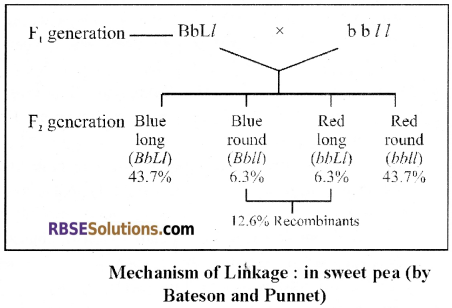
- The above results in 7:1:1:7 ratio were obtained. This suggests that new combinations or recombinants were less and a number of parental plants were more.
- It means the selected genes for the study have not followed the law of independent assortment, but their nature showed linked inheritance or they show Linkage.
- The genes present on the same chromosome show their nature to inherit together are called Linked genes and the incidence is known as Linkage.
- Sometimes a group of genes found on a single chromosome are inherited together, is called Linkage group.
![]()
Question 5.
Explain various types of linkage.
Answer:
Various Types of Linkage:
Linkage is of two types –
- Complete linkage:
When certain genes located so nearly on the same chromosome and tend to remain linked together while passing from one generation to another without new combinations are termed complete linkage. - Incomplete linkage:
Linked genes are not inherited always in their combination. In the homologous chromosomes or at the time of meiosis exchange of such genes may be found due to crossing over. The genes located at distance on the chromosome are also incompletely linked because of more chances of isolation by crossing over in these.
Question 6.
What are sex-linked character and their inheritance?
Answer:
Sex-linked Inheritance:
- The human female has XX chromosomes and the human male has XY chromosome along with 44 autosomes in both sexes.
- The genes present on the X chromosome may express in both male and female gender and hence it is called crisscross heredity. While genes present on Y – chromosome found only in the male.
- Genes of approximately 20 characters found on the X chromosome of human are sex-linked characters and a father can not transmit sex-linked traits (of the X chromosome) to his sons, it can be passed on to the daughters only. Some of the
- sex-linked hereditary diseases found in human beings are as follows:
- Colour Blindness
- Haemophilia
RBSE Class 12 Biology Chapter 36 Essay Type Questions
Question 1.
What do you mean by sex-linked inheritance? Discuss it with reference to colourblindness and haemophilia diseases.
Answer:
1. Sex-linked Inheritance:
- The human female has XX chromosomes and the human male has XY chromosome along with 44 autosomes in both sexes.
- The genes present on the X chromosome may express in both male and female gender and hence it is called crisscross heredity. While genes present on Y- chromosome found only in the male.
- Genes of approximately 20 characters found on the X chromosome of human are sex-linked characters and a father can not transmit sex-linked traits (of the X chromosome) to his sons, it can be passed on to the daughters only.
Some of the sex-linked hereditary diseases found in human beings are as follows:
Colour blindness:
- It is a hereditary disease. In this disease, the person is unable to differentiate different colours.
- The colourblindness is of two types –
- Red-Green colourblindness
- Blue colourblindness
- This disease is mainly found in men because males have only one X chromosome. If X – chromosome contains recessive allele of pigment formation gene than no cone formation takes place and man suffers from colour blindness. While two X – chromosomes are found in a woman and hence woman may be a carrier of this disease or may suffer from this disease.
Red-Green colourblindness:
- It is caused due to the absence of red/green cones and it is also called as protanopia/Deuteranopia.
- The person is unable to distinguish red, green, yellow and orange colours. These colours appear to red in the absence of green cones and green in the absence of red cones.
Blue colourblindness:
- It is caused due to the absence of blue cones.
- Such a person is unable to distinguish violet, Indico, Blue and Green colours. They all appear to be green.
2. Inheritance of colourblindness:
- Example 1: Cross between a normal woman and a colourblind man.
- If a colour blind male marries with a normal female the possibilities would be – All children (son and daughters) would be normal, but the daughters would be carriers. Because they are heterozygous, they will not be colourblind.
- The woman acts as a carrier of colourblindness.
- Example 2: Cross between a carrier woman and a colourblind man.
- In this cross, 50% of girls will be colourblind and 50% of girls will be a carrier.
- Similarly, 50% of boys will be normal and 50% of boys will be colourblind.
- Conclusion: Following are conclusions regarding heredity of colour blindness:
- Identification of colours in the vision is a sex-linked character. Its gene is located on the X chromosome and its allele is not found in males.
- Males are more sufferer from this disease. Because if the normal gene for colour differentiation is absent on X chromosome man than the colour blindness the disease is found.
- Women have two X-chromosomes and both X chromosomes have the gene for colour identification and expression.
- While only one chromosome in man has a gene for colour identification and expression. If only one X chromosome carries the recessive gene for colourblindness in woman than the normal woman becomes the carrier of the disease.
- Gene for the identification of colours is dominant. If both X chromosomes of woman carry this recessive gene then a woman will be colour-blind.
- Father and son of a colourblind woman are also colour blind. If the husband of a colour blind woman is also colour blind than their daughters will be colour blind. Daughter (normal) of a colour blind father produce 50%sons of normal vision and 50% sons as colourblind.
3. Haemophilia or Bleeder’s disease:
- It is a sex-linked hereditary disease which results in delayed or no blood clotting. It was first discovered by John Otto.
- Haldane discovered haemophilia in the family of Queen Victoria. It is caused due to one recessive gene on the X – chromosome of man.
- It is also called as Royal disease or bleeder’s disease. It is expressed only in men The women act as a carrier of this disease. Recessive genes on both the X – chromosomes cause haemophilia in females but they do not survive.
- Father of haemophilia female is always haemophilic.
- Haemophilia is of 2 types –
- Haemophilia – B or Christmas disease: It is caused due to the absence of factor – IX. It is a weak type of haemophilia.
- Haemophilia – A: It is caused due to the absence of factor – VIII (AHG).
- This disease is also due to the recessive gene located on the X chromosome. Haemophilic man and normal woman produce 50% carrier daughters and 50% normal sons.
- Carrier woman and normal man produce 25% carrier daughters, 25% haemophilic sons, 25% normal daughters and 25% normal sons.
- This disease is found only in males as males have only one X chromosome. If a woman has both recessive genes on their X chromosomes than such woman cannot survive, because blood flow during menstruation does not stop and hence it is fatal for them.
- When females contain only one recessive gene of haemophilia on the X chromosome and other X chromosomes without such gene, they are a carrier of haemophilia.
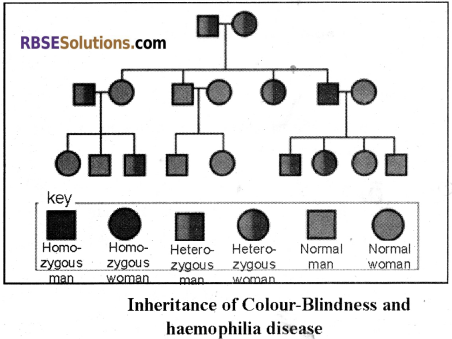
![]()
Question 2.
Differentiate between linkage and crossing over.
Answer:
1. Linkage:
- Mendel’s principle of independent assortment is truly applicable for both genes and chromosomes. Genes control various characteristics of the organisms and gene is a basic unit of heredity.
- First-time German scientist Sutton studied the interrelationship between factors and chromosomes. He discovered linkage.
- According to him in each pair of chromosome one chromosome is from each parent, (paternal and maternal member).
- It is the reason by which the genes present on separate chromosomes are independently assorted, but all genes present on the same chromosome are said to be linked and should be inherited together.
- A single chromosome may carry a large number of genes.
- All the genes located on the same chromosome are said to be linked genes. The characters controlled by these genes are said to be Linked characters.
- These linked genes have a tendency to be inherited together but independently. Genes present on a single chromosome are not independently assorted.
- Bateson and Punnet (1906) explained about linked genes in his experiment on sweet pea (Lathyrus odoratus).
An experiment of Bateson and Punnet:
- Bateson and Punnet (1906) did a dihybrid cross on plants of blue flowers and long pollens with red flower and round pollen plant and found the following results:
[Abbreviations: Blue flower = B, Red flower = b, Long pollens = L and round pollens = L.] - A cross between Blue flower and long pollens (BBLL), and red flower and round pollens yielded blue flowers and long pollens in the F1 generation.
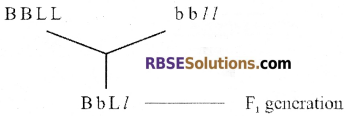
- Now they made a test cross between heterozygous F1 offsprings (BbLl) with homozygous recessive parent (bbll). By the concept of linked genes and independent assortment BbLl should give four kinds of gametes and hence four phenotypes in equal proportions 1:1:1:1 were expected. But Bateson and Punnet obtained the following results –
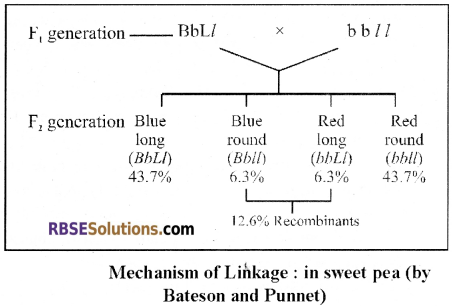
- The above results in 7:1:1:7 ratio were obtained. This suggests that new combinations or recombinants were less and a number of parental plants were more.
- It means the selected genes for the study have not followed the law of independent assortment, but their nature showed linked inheritance or they show Linkage.
- The genes present on the same chromosome show their nature to inherit together are called Linked genes and the incidence is known as Linkage.
- Sometimes a group of genes found on a single chromosome are inherited together, is called Linkage group.
Various Types of Linkage:
Linkage is of two types –
- Complete linkage:
When certain genes located so nearly on the same chromosome and tend to remain linked together while passing from one generation to another without new combinations is termed complete linkage. - Incomplete linkage:
Linked genes are not inherited always in their combination. In the homologous chromosomes or at the time of meiosis exchange of such genes may be found due to crossing over. The genes located at distance on the chromosome are also incompletely linked because of more chances of isolation by crossing over in these.
2. Crossing Over:
- Bateson and Punnet obtained some recombinant type plants during experiments. It is because of a special process called crossing over.
- In crossing over an exchange of genetic material takes place between non-sister chromatids of homologous chromosomes. It results in the formation of new combinations.
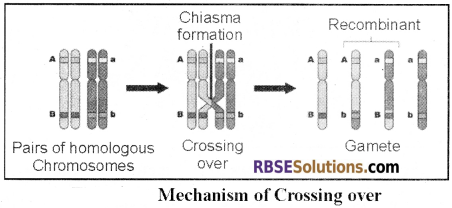
- During prophase I of meiosis there is an exchange of parts of chromatids between homologous chromosomes. The homologous chromosomes become intertwined and the chromatids of homologous chromosomes cross over at certain point called Chiasmata.
- The Chromatids break at this point and then rejoin. Crossing over results in the exchange of corresponding segments at the same locus between the paternal and maternal chromosomes (means non-sister chromatids of homologous chromosomes). Linked genes separate from each other by crossing over and new combinations appear.
Types of Crossing over:
- On the basis of the number of Chiasma formation in the chromosomes, the three types of crossing over are found –
- Single Crossing over When only one chromatid of homologous chromosomes participate in crossing over and only one chiasma is formed. It is called Single crossing over.
- Double-crossing over: When two, three or all four chromatids of homologous, chromosomes participate in crossing over and two chiasmata are formed. It is known as Double-crossing over.
- Multiple Crossing over When more than two chiasmata are formed between two non-sister chromatids. It is called multiple crossing over.
Significance of Crossing Over:
- This process occurs during the pachytene stage of prophase – I of meiosis.
- It occurs between non-sister chromatids of homologous chromosomes.
- Exchange of segments or genes between non-sister chromatids is known as Crossing over.
- Numbers of points of a chromosome where crossing over takes place at a single time depends on the length of the chromosome. Percentage of crossing over increases with the increase in the length of a chromosome.
- Distance between the genes in a chromosome affects the probability of crossing over. More distance between genes increase the probability of crossing over and if the distance is less than there is a decrease in the probability of crossing over.
![]()
Question 3.
Describe various chromosomal aberrations in man.
Answer:
Human Chromosomal Disorders(Abnormalities):
- Chromosomal disorders occur due to a change in the number of chromosomes or change in their structure.
These abnormalities are of two types:
1. Autosomal Abnormalities:
1.1. Mongolism or Down’s Syndrome:
- This abnormality was first described by Langdon Down in 1866.
- The person suffering from. Down syndrome has 47 chromosomes.
- This is due to one extra 21st chromosome. Hence, it is also called 21st Trisomy. Down syndrome is found in one out of 600 children.
- Such defect generally occurs in a child which is born by the woman of more than 40 years ago. It is due to one extra 21st more chromosome the ovum at the time of meiotic division (expulsion of the polar body), so instead of 23 chromosomes, there are 24 chromosomes in the ovum.
- A child develope from such ovum contains 47 chromosomes and abnormality develops is Down syndrome.
Salient Features:
- They have protruding round heads, webbed neck.
- A furrowed tongue that causes the mouth to remain partially open and short.
- Broad hands with blunt fingers and characteristic fingerprint patterns.
Physical, psychomotor and mental development is retarded. Life expectancy is shortened.
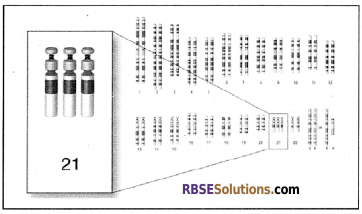
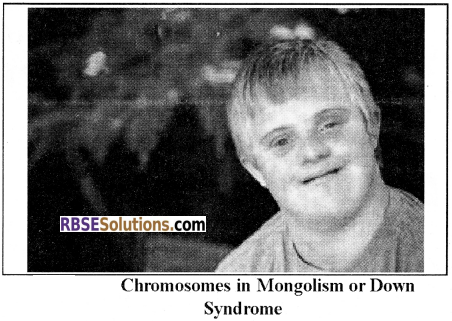
1.2. Edward’s Syndrome:
- It is caused due to one extra 18th chromosome (45 + 2 = 47). Hence, it is also called as 18th Trisomy.
- It occurs in one out of 6000 persons.
- Symptoms: Mentally retarded, congenital heart disease, Polydactylous, Maximum life of 6 months.
1.3. Cry du Chat Syndrome:
- It is caused due to loos of small arm (p – arm) of the 5th chromosome.
- It is also called the cat’s cry syndrome.
- Symptoms: Microcephaly, Infant voice resembles the cat’s cry.
2. Allosomal Abnormalities:
- Following are main autosomal abnormalities.
2.1. Turner’s Syndrome:
- A person suffering from this disease is always a woman.
Such a woman has only one X chromosome instead of two and hence a total number of chromosomes found are only 45 (44 + X 0). It is called Turner’s Syndrome. - One girl born per 3000 as turner syndrome.
- Symptoms:
- Such women are of short stature.
- Broad chest and lack of secondary sexual characteristics and sterile.
- Short neck, underdeveloped mammary glands
- Mental – retardedness
2.2. Klein felters Syndrome:
- A person suffering from this disease is a man.
- Such man has 47 or 48 or 49 total chromosomes instead of 46 in their cells. This additional number is either of X or Y chromosome. Klinefelter’s syndrome in man may have chromosomes as:
- 44 + XXY (One additional X chromosome) = 47
- 44 + XXXY (two additional X chromosome) = 48
- 44 + XXXXY (three additional X chromosome) = 49
- 44 + XXYY (addition one X and one Y chromosome) = 48
- 44 + XXXYY (Additional two X and one Y chromosome) = 49
- Such males with an abnormal number of chromosomes have feminine characters. Specific features of a Klinefelter’s syndrome are:
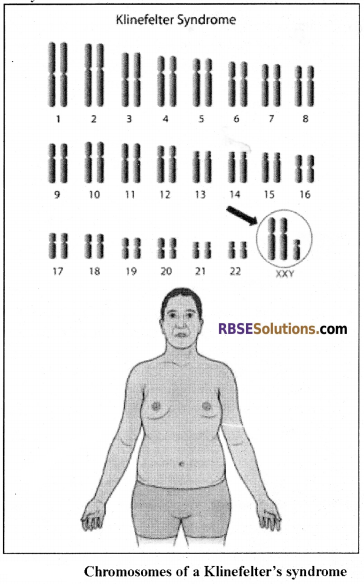
- In 2A + XXX condition (47), the female has usually normal genitalia, limited fertility and slight mental retardedness.
Higher doses of X chromosomes may lead to more pronounced effects. In the male, the mammary glands are like female and this, the condition is called Gynaecomastia (gina = woman and massage = male with mammae). Hands and Legs are long as to compare to the normal one.
2.3. Super Female:
- In women sometimes a total number of chromosomes may be up to 47 to 49. This increased number is due to additional X chromosomes –
- 44 + XXX ⇒ 47
- 44 + XXXX ⇒ 48
- 44 + XXXXX ⇒ 49
- Symptoms:
- Such women are of low mental ability.
- Delayed sexual development.
- Highly beautiful.
- More emotional.
2.4. Jacob’s syndrome:
- It is also called as a criminal syndrome.
- It is caused due to one extra Y-chromosome in Man (44 + XYY = 47).
- Symptoms:
- Abnormal development of sex organs.
- Exceptionally tall and stout body.
- Low mental level.
- The criminal tendency since birth.